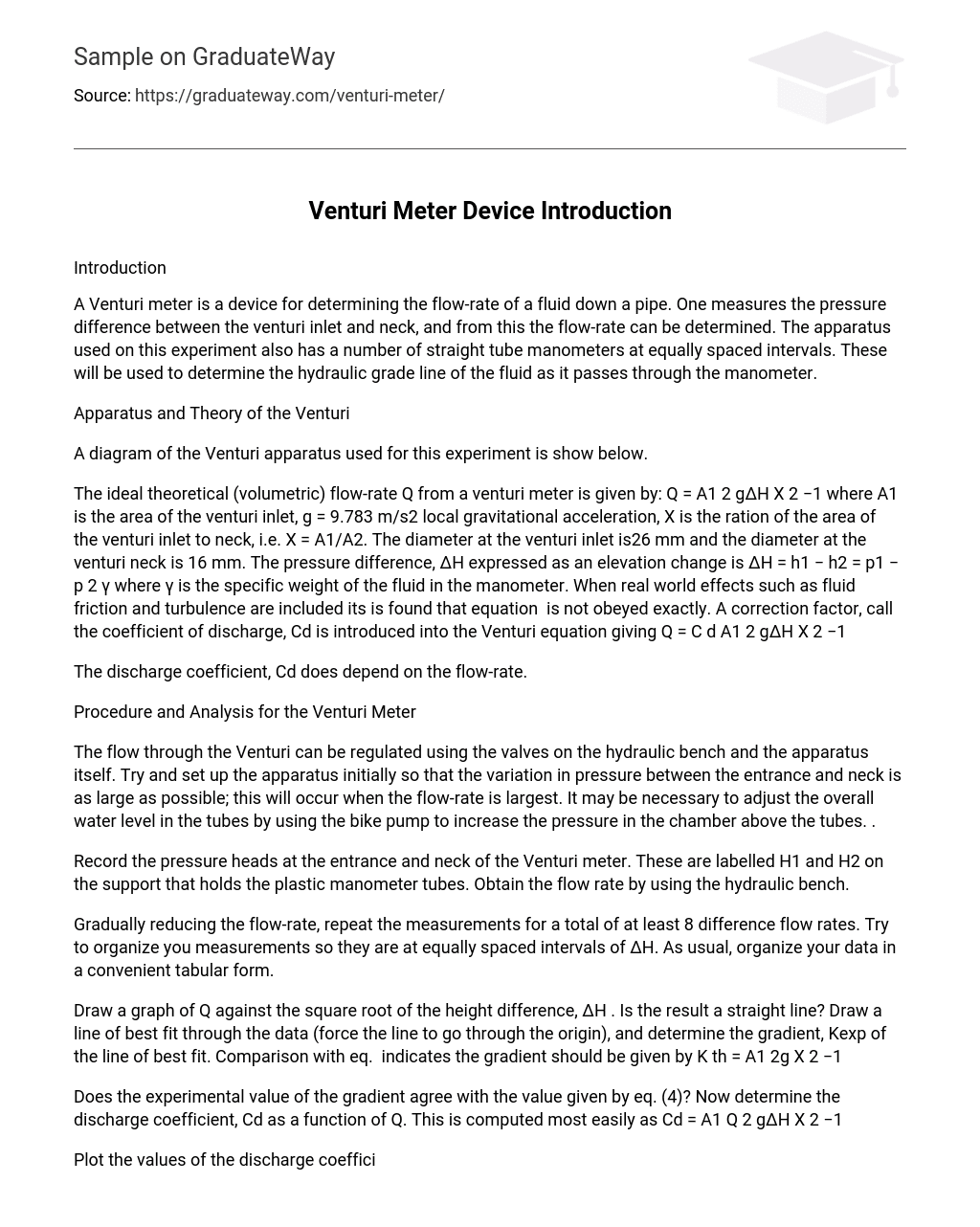Introduction
A Venturi meter is a device for determining the flow-rate of a fluid down a pipe. One measures the pressure difference between the venturi inlet and neck, and from this the flow-rate can be determined. The apparatus used on this experiment also has a number of straight tube manometers at equally spaced intervals. These will be used to determine the hydraulic grade line of the fluid as it passes through the manometer.
Apparatus and Theory of the Venturi
A diagram of the Venturi apparatus used for this experiment is show below.
The ideal theoretical (volumetric) flow-rate Q from a venturi meter is given by: Q = A1 2 g∆H X 2 −1 where A1 is the area of the venturi inlet, g = 9.783 m/s2 local gravitational acceleration, X is the ration of the area of the venturi inlet to neck, i.e. X = A1/A2. The diameter at the venturi inlet is26 mm and the diameter at the venturi neck is 16 mm. The pressure difference, ∆H expressed as an elevation change is ∆H = h1 − h2 = p1 − p 2 γ where γ is the specific weight of the fluid in the manometer. When real world effects such as fluid friction and turbulence are included its is found that equation is not obeyed exactly. A correction factor, call the coefficient of discharge, Cd is introduced into the Venturi equation giving Q = C d A1 2 g∆H X 2 −1
The discharge coefficient, Cd does depend on the flow-rate.
Procedure and Analysis for the Venturi Meter
The flow through the Venturi can be regulated using the valves on the hydraulic bench and the apparatus itself. Try and set up the apparatus initially so that the variation in pressure between the entrance and neck is as large as possible; this will occur when the flow-rate is largest. It may be necessary to adjust the overall water level in the tubes by using the bike pump to increase the pressure in the chamber above the tubes. .
Record the pressure heads at the entrance and neck of the Venturi meter. These are labelled H1 and H2 on the support that holds the plastic manometer tubes. Obtain the flow rate by using the hydraulic bench.
Gradually reducing the flow-rate, repeat the measurements for a total of at least 8 difference flow rates. Try to organize you measurements so they are at equally spaced intervals of ∆H. As usual, organize your data in a convenient tabular form.
Draw a graph of Q against the square root of the height difference, ∆H . Is the result a straight line? Draw a line of best fit through the data (force the line to go through the origin), and determine the gradient, Kexp of the line of best fit. Comparison with eq. indicates the gradient should be given by K th = A1 2g X 2 −1
Does the experimental value of the gradient agree with the value given by eq. (4)? Now determine the discharge coefficient, Cd as a function of Q. This is computed most easily as Cd = A1 Q 2 g∆H X 2 −1
Plot the values of the discharge coefficient against the flow-rate Q. Is there any consistent trend evident in your graph?
Determination of the Hydraulic Grade Line
The purpose of this section will be to make a plot of the hydraulic grade-line as the fluid goes through the Venturi meter. We know from Bernoulli’s equation that the energy line is given by v2 EL = + +z γ 2g p
The hydraulic grade-line is taken to be HGL = p γ +z
As the diameter of the pipe changes, the level of the hydraulic grade-line will change because the dynamic pressure increases at the venturi contractions.
Set up the apparatus so that the variation in pressure between the entrance and neck is as large as possible; this will occur when the flow-rate is largest. It may be necessary to adjust the overall water level in the tubes by using the bike pump to increase the pressure in the chamber above the tubes. Measure the height of the water column in all the manometer tubes and also measure the flow rate. From the flow rate you should be able to determine the fluid velocity at different points along the venturi as long as you know the venturi diameter. . Is the height in the rightmost manometer tube the same as the height in the first manometer tube? Assuming the pressure in the chamber above the tubes is atmospheric and neglecting the distance from the bottom of the scale to the venturi taps (this assumption is made simply so we can work with some numbers, its validity will affect the overall height of the energy line but not the differences in the energy line from one point in the venturi to the next) draw a plot of the energy line at the different tapping points along the venturi tube. The energy line will be for a series of points along the center of the Venturi tube.
Lecturer/Technician Notes
- E Markland, A first course in Hydraulics, (Long Eaton, England : Tecquipment, 1976.) 621.2078. Bike pump with pump connection should be checked.





